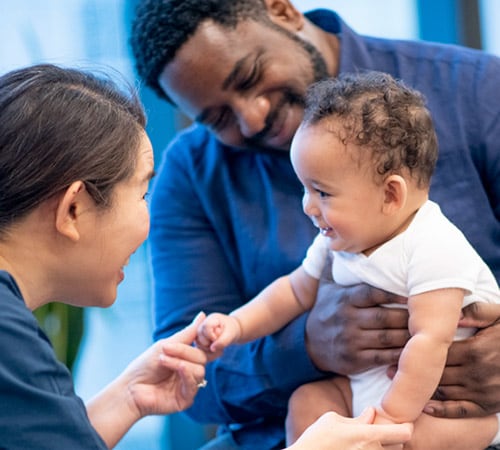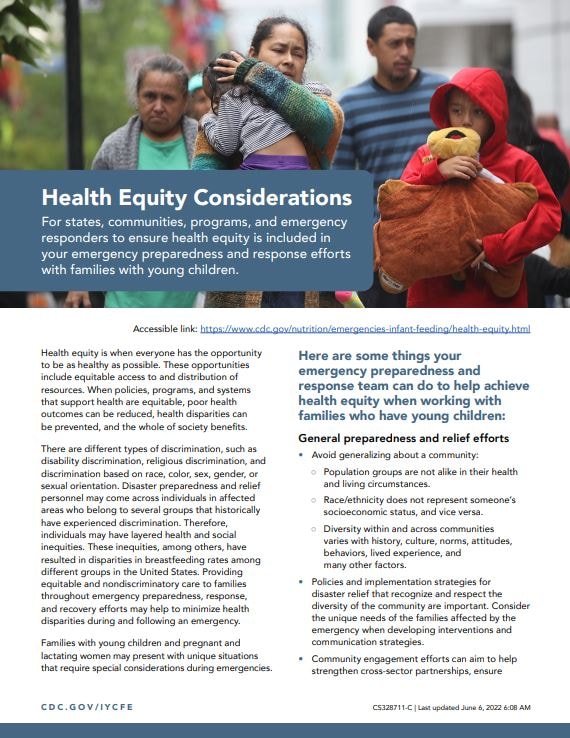Health Equity Considerations
For states, communities, programs, and emergency responders to ensure health equity is included in your emergency preparedness and response efforts with families with young children.
Health equity is when everyone has the opportunity to be as healthy as possible. These opportunities include equitable access to and distribution of resources. When policies, programs, and systems that support health are equitable, poor health outcomes can be reduced, health disparities can be prevented, and the whole of society benefits.
There are different types of discrimination, such as disability discrimination, religious discrimination, and discrimination based on race, color, sex, gender, or sexual orientation. Disaster preparedness and relief personnel may come across individuals in affected areas who belong to several groups that historically have experienced discrimination. Therefore, individuals may have layered health and social inequities. These inequities, among others, have resulted in disparities in breastfeeding rates among different groups in the United States. Providing equitable and nondiscriminatory care to families throughout emergency preparedness, response, and recovery efforts may help to minimize health disparities during and following an emergency.
Families with young children and pregnant and lactating women may present with unique situations that require special considerations during emergencies.
Here are some things your emergency preparedness and response team can do to help achieve health equity when working with families who have young children:

General preparedness and relief efforts
- Avoid generalizing about a community:
- Population groups are not alike in their health and living circumstances.
- Race/ethnicity does not represent someone’s socioeconomic status, and vice versa.
- Diversity within and across communities varies with history, culture, norms, attitudes, behaviors, lived experience, and many other factors.
- Policies and implementation strategies for disaster relief that recognize and respect the diversity of the community are important. Consider the unique needs of the families affected by the emergency when developing interventions and communication strategies.
- Community engagement efforts can aim to help strengthen cross-sector partnerships, ensure culturally and linguistically appropriate practices, include culturally appropriate community partners, build trust within communities, and promote social connection.
- Continue providing families with disability services before, during, and after public health emergencies. Ensure equal access to public health services for people with disabilities.
- Be aware that not every family is the same, and that some children are not being raised by their biological parents. Build flexibility into community guidance and public health communications to allow full participation for all caregivers.
- Learn about a family’s infant feeding practices by asking open-ended questions such as “How have you been feeding your baby?” rather than questions that can be answered with yes or no such as “Are you breastfeeding your baby?”
- Some people have experienced violence, abuse, and trauma, which can impact infant feeding practices. It is important to provide these families with qualified trauma-informed care, as well as access to privacy as needed. Hands-off lactation assistance may be preferred.
Language

Use non-stigmatizing, bias-free language. Consider the following when responding to emergencies:
- Use person-first language. For example, use “people experiencing homelessness” instead of “the homeless” and “person with diabetes” instead of “diabetic.”
- Use terms that are inclusive of all gender identities such as “pregnant person,” “breastfeeding parent,” and “lactating person.”
- Do not refer to people as their race/ethnicity, for example Blacks, Hispanics, Latinos, Whites. Preferred terms for specific racial/ethnic groups are:
- American Indian or Alaska Native persons (identify by specific tribal affiliations when possible)
- Asian persons
- Black or African American persons
- Hispanic or Latino persons
- Native Hawaiian or other Pacific Islander persons
- White persons
- People who identify with more than one race/ethnicity; people of more than one race/ethnicity
Pronoun Use
- Ask which terms, names and pronouns are preferred by the individuals being supported.
- When introducing oneself, announcing one’s own pronouns may make it easier for others to share their pronouns.
- If an individual corrects your pronoun use, it’s best to briefly acknowledge the mistake and correct the pronoun going forward. Spending too much time apologizing for the error can bring more attention and discomfort to the simple mistake.
If you have questions about infant nutrition or medications before and while breastfeeding, please consult with your healthcare provider. You can find more information on medications and breastfeeding here and on the National Institutes of Health’s Drugs and Lactation Database (LactMed®).
- Transgender and nonbinary-gendered individuals may give birth and breastfeed or feed at the chest (chestfeed). The gender identity or expression of transgender individuals is different from their sex at birth. The gender identity of nonbinary-gendered individuals does not fit neatly into either man or woman.
- An individual does not need to have given birth to breastfeed or chestfeed.
- Some families may have other preferred terminology for how they feed their babies, such as nursing, chestfeeding, or bodyfeeding.
Health Equity Resources
CDC offers resources to assist health departments with their strategic planning to strengthen public health preparedness capabilities and help address health equity. A few key resources include the following:
- The Access and Functional Needs Toolkit provides a framework to organize planning for broad groups of people with disabilities and others with access and functional needs, recommended action steps, and noteworthy practices from the field.
- The Community Assessment for Public Health Emergency Response (CASPER) toolkit can assist local, state, regional, or federal officials to conduct a rapid needs assessment before or following an emergency to determine the health status, basic needs, or knowledge, attitudes, and practices of a community in a quick and low-cost manner.
- The Disability and Health Emergency Preparedness webpage offers resources that public health professionals, emergency personnel and communities can use to create emergency preparedness and response plans that are inclusive of people with disabilities.
- The tribal support webpage provides information for tribal governments and their partners to serve tribal communities more effectively and includes consideration of the unique cultural and traditional needs of those communities.
- Planning for an Emergency: Strategies for Identifying and Engaging At-Risk Groups [PDF-12.2MB] provides examples of approaches and tools that can help emergency managers identify, plan for, and assist at-risk populations.
- The Health Equity Guiding Principles for Inclusive Communication provides information to help public health professionals, particularly health communicators, to ensure their communication products and strategies adapt to the specific cultural, linguistic, environmental, and historical situation of each population or audience of focus.

